If you have been to health clubs in recent years, you may have noticed a few people rolling and writhing around on cylindrical pieces of foam. The technique is called foam rolling and probably doesn’t look all that inviting given the grimaces on the faces of some who practice it. Despite its appearance, however, foam rolling can actually help you feel better and perform better in your workouts.
Foam rolling is also called myofascial release and is designed to work out the “knots” in your muscles. You could compare the practice to self-massage. The technical terms for “knots” are trigger points or myofascial adhesions. Fascia is a form of connective tissue that wraps and bundles muscles (myo) together. Myofascial adhesions can develop through stress, training, overuse, underuse, movement imbalances and injuries. They are essentially points of constant tension and addressing them can have a positive effect on your workouts. Ignoring them can lead to further dysfunction and may perpetuate and/or cause injury.

As you might imagine, muscles and fascia do not literally tie themselves into knots. However, the analogy isn’t too much of a stretch (no pun intended). Take an elastic band and tie a knot in the center and stretch the band. The elastic around the knot can stretch, but the knot itself will stay put and get tighter. This will result in a “speed bump” of sorts, affecting the shortening and lengthening of the affected area. This is not unlike the functionality of muscles. The area around the adhesion gets worked, but the area affected by the adhesion will not reap the same benefits. In other words, the rich part of the muscle gets richer, while the poor part stays poor.
The Bad News and the Good News
The bad news is that foam rolling is not noted for its comfort. The good news, however, is that you can and should control the amount of pressure applied and steer clear of pain. Learning how to control the amount of pressure to a mild and tolerable discomfort is important. The objective of rolling is to help the area relax, and applying too much pressure can reflexively invite the opposite response. When introducing pressure to a sensitive area, you may experience a slight knee-jerk type reflex. But if you do not go in too hard, you should experience what feels like air being slowly let out of a tire.
In highly sensitive areas, eliminating tension completely is not likely to happen following one application. However, some improvement can be noticed immediately. With consistent and diligent application applied to the peskiest areas, elimination of chronic adhesions may be possible.
Application: Ease in, Search and Eliminate
As with all things exercise related, you should ease yourself in gradually. Start with a softer roller (if available) and prioritize how to control your body on the roller and the amount of pressure you apply. It is better to be too soft than too hard, especially in the beginning. Once you feel a comfortable level of control, administer pressure to the most sensitive areas for roughly 20 to 30 seconds. As you get to know your body and how it responds to foam rolling, you may go shorter or longer as needed.
Prioritizing
It is very possible to find several trigger points throughout your body. Spending time on each one may take a while and won’t be much fun. Therefore, you can prioritize what to focus on in two ways: 1) address the muscles you are working that day; and/or 2) address the areas that are most sensitive.
When starting out, take inventory over a couple of workouts to determine your areas of greatest need. A great way of identifying needs is to compare left and right sides. Most of the muscles rolled will be the extremities and can be rated on a sensitivity scale of 1-10 on each side. It is very common for one side to be more sensitive than the other. The more sensitive side deserves more attention and should become the higher priority. But keep comparing sides. If done well and consistently, sensitivity should decrease and left and right differences will balance out.
When to Perform
Foam rolling can be performed prior to and after your workouts. When applying prior to your workout, only focus on problematic areas. Remember, foam rolling is designed to reduce tension and relax a muscle. Doing this to a healthy muscle may relax it to the point of being less effective during your workout. But for muscles that carry excessive tension, spending time on the front end of training can help reduce poor and imbalanced movements during your workout. Post-workout rolling can focus on all of major muscles worked, with an extra emphasis on the areas that appear problematic.
Foam rolling is one strategy that can help improve symmetry in the body. By taking a few minutes during each workout (and each day if necessary) to work out adhesions, you can help prepare for, and recover from, exercise more effectively. Tension can be released from the area, while blood flow and nutrients can increase, leading to healthier muscle tissue and a more effective fitness program.
Instructions: Search the entire muscle to find one or two of the most sensitive spots. Once there, apply pressure on the spot until some tension is released. Either stay on the spot longer, or generate small movements back and forth.
The exercises below target several common areas that can benefit from foam rolling, including the calves, glutes, inner thighs, outer thighs (IT band) and lats.
Foam Rolling Exercises
1. Mid-upper Back
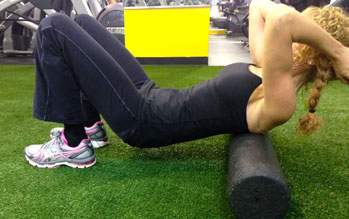
- Lean back against the roller, positioning it beneath your shoulder blades.
- Raise your hips slightly and maneuver your body up and down to find sensitive areas.
- Keep the roller between you shoulder-blade region. Avoid the neck and lower back, where there is little support.
- Take slow, deep breaths.
2. Calves
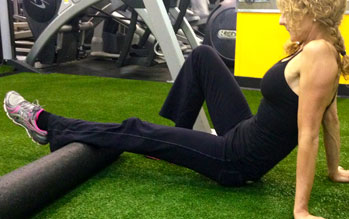
- In a seated position, support your body with your hands behind you to prop yourself up.
- Place one leg on the roller starting at the lower calf (above the Achilles).
- Roll your calf by moving your body slowly toward the roller.
- Search for sensitive areas along the calf.
- Turn the leg inward and outward to explore more areas.
3. Inner Thigh (Adductors)
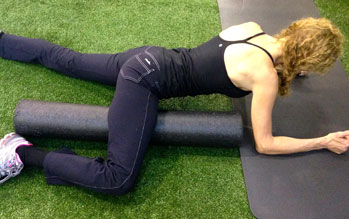
- Begin in a face-down position and place the roller parallel to your body.
- Work your way slowly to the upper groin area until you identify the most sensitive area.
4. Lats (Latisimus Dorsi)
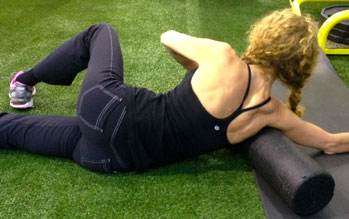
- Rest the roller at a slight angle toward the back side of your armpit.
- Rock your body forward and backward and up and down to search for sensitive areas.
5. Gluteus Maximus/Piriformis

- For the glutes (Figure A), rest your weight your left elbow with the roller above the hipbone. Find the sensitive area and switch sides and compare.
- For the piriformis (Figure B), which is often a sensitive area, sit on the roller and support your body with your left hand on the floor. Cross your left ankle onto the right knee and search for sensitive area. Switch sides and compare.
- Use contact points on the floor to control the amount of pressure.
6. Outer Thigh (IT Band and Lateral Quadriceps)
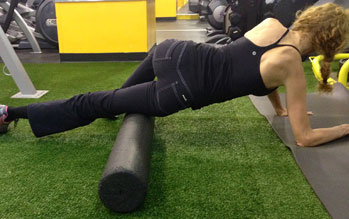
- The outer thigh is highly sensitive. Use caution and ease in.
- From a side-plank position, place your right elbow on the floor and your left hand and left foot on the floor in front of your body. (Note: These are your main contact points to control the amount of weight you rest on the roller.)
- Use contact points on the floor to control the amount of pressure.
- Start above the outside of the knee and slowly maneuver your body over the roller toward your hip.
Chris McGrath, M.S., is the founder of Movement First, a New York City-based, health and fitness education, consulting and training organization. With more than 20 years of fitness and coaching experience, McGrath specializes in a variety of training modalities including sports performance, injury prevention, post-rehabilitation and lifestyle/wellness coaching. McGrath is a Senior Fitness Consultant to the American Council on Exercise and has established himself as an international fitness expert.
This article was posted from ACEFitness.org. The original article was published on Oct. 3, 2013.